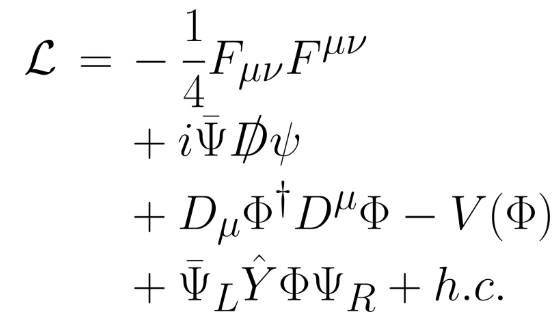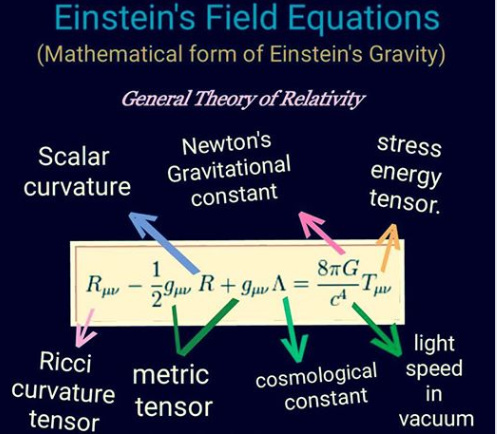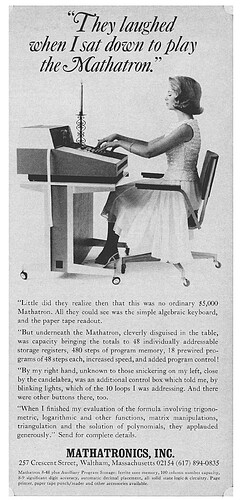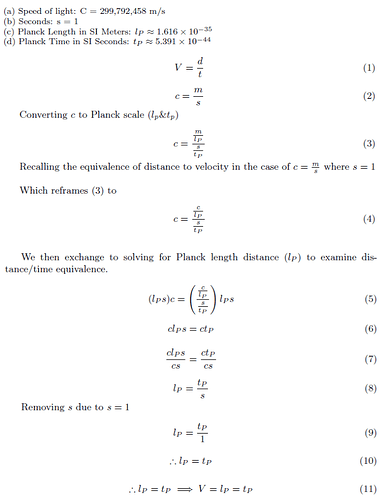Alright, we’re off in opinion land…
I usually stay clear of this nuance because the real honest answer is we don’t experimentally know reality at these scales, and a lot of what’s said about what happens at these extremes is from interpreting residual effects and combining that with math of relativity, and applying a sense of logic to the interpretation of what that means.
The typical understanding of all of this starts from an axiom that time has a motion, and that relativity causes that motion to be relative in at least speed by comparison to another frame of reference.
There is also an axiomatic position that time is a physical property that has the ability to be altered and manipulated independent of any other physical object’s properties.
These are interpretations. They are not hard facts. They are axiomatic interpretations.
As it happens, I believe them to be in error.
I don’t mean that all of science is wrong, and I’m genius type of “error”. I simply mean I disagree with the interpretation, just as I disagree with the Copenhagen interpretation of quantum mechanics for the most part.
It should be tolerated to disagree with an interpretation, but not a fact. Primarily because the former presumes a condition, but cannot directly prove it evidentially. It may do so circumstantially, but not directly.
I’m going to speak as if from a position of fact in tone following this sentence because typing the implied caveat of belief is unnecessarily long winded.
Alright…here we go…

The three axioms of the current interpretation are:
- Time is a substantial physical property that can be altered independent of other physical properties.
- Time has a motion.
- The motion of time is relative to the reference frame of the observer.
The third axiom is derived from holding the first two axioms and interpreting the results of General Relativity.
We cannot violate General Relativity, so we cannot violate General Relativity’s finding that time is relative to the frame of reference of the observer.
We will not violate this finding, but we will show axiom 3 to not be required to not violate General Relativity.
We’ll go through each one.
Time is a substantial physical property that can be altered independent of other physical properties.
No. Time does not exist. This assumption is simply an assumption.
No one has ever measured a physical property of time.
Time is a mathematical function which quantifies the difference in reference frame between reference frame A (RFa) and reference frame B (RFb).
Prior to General Relativity, all physics assumed an interpretation that time was constant and everything else was relative to time. This made some sense because until you use very sensitive equipment and go to great heights with the specific purpose of examining the malleability of time, you easily see time as absolute in speed everywhere on this planet.
Furthermore, when you do astronomy - or at least astronomy up to that point, you don’t observe the planets in the solar system behaving as if they are operating on different speeds of time. Indeed, if you saw an oddity with regard to speed, you would rather naturally assign the issue to the physical motion of the planet’s orbital velocity; not one of variable time.
However, when Einstein began to pick away at the issues surrounding light as a wave or particle, and began to imagine his environment from the position of considering the travel of light, he realized a rather obvious observation that was so obvious that no one had taken note of it. Mediums aside, light appears to arrive at the different times to different observers dependent upon their relationship of motion in respect to the motion of the light. This is a paradox, if you stop and think about it, and he did, because clearly a lighting bolt has an absolute frame of reference to where it struck the ground, yet depending on your motion and position relative to that lightning strike, you may observe the order of events differently.
The thought is of light relative to a train. Einstein used two lightning bolts, but we can simplify the model to one light source. If we have a light in the train and we trigger it to flash at a specific observation point outside of the train where we have a high speed camera, and we have a high speed camera inside the train at the front and back, then when the light is triggered, the high speed cameras inside will show light hitting the front and back of the train at the same time.
However, if we check the high speed camera outside of the train, then we’ll find that it reaches the back of the train before it reaches the front of the train. This is because the train is moving in one direction, and the opposite direction of the train’s motion causes there to be less time between the light hitting the back of the train because the back of the train is moving toward the light, while the front of the train will find light taking longer because the train is moving away from the light.
The difference will be tiny. With lightning at a distance and traveling objects, it’s more directly noticed.
We just happen to be in one reference frame, so we don’t think much about it. It’s when you compare the two reference frames that it stands out.
What this means, ultimately, is that light must be constant in both reference frames because only if the speed of light is constant can it behave in this way. It must travel in all directions at the same speed, regardless, or it wouldn’t factor into the speed of the train in the external observation as such an observation indicates that the light isn’t being affected by the speed of the train, unlike a ball or sound.
So if light became a constant, this presented a problem because time was a constant, but if you held both as a constant, then physics broke down and the equations stopped working.
If you let loose time and let it be relative and hooked on light as the constant, however, then everything worked out correctly.
So time must be relative. Einstein then went further by adopting the new position originally put forward by Henri Poincare. Poincare was working on international time zone issues, and attempting to solve the issue of clocks and their annoying habit of not synchronizing. He worked out an imaginary placement for time in a 4 dimensional geometry which worked well for the solution and his work on this lead to Principles of Relativity, which was expanded upon by Minkowski who ended up claiming that henceforth space and time would no longer be separate. Einstein followed suit with this new thinking and it fit perfectly well with his findings.
It is all the way back here in the first few years of the 20th century that we must go to correct our misconception of time, for we coupled time and space together into spacetime, but now still talk of time as if it is a separate thing unto itself.
We have ignored the opening adamant declaration of Minkowski’s 1908 lecture “Space and Time”.
From now onwards space by itself and time by itself will recede completely to become mere shadows and only a type of union of the two will still stand independently on its own.
Minkowski was Einstein’s professor, btw.
Anyway, Minkowski’s discussions are very complex and nuanced, so most don’t end up really hearing much of what he formulated because the important bits mostly are found in General and Special Relativity as a general sciences level of knowledge.
However, there is one thing that Minkowski, like Einstein noticed that was so straight forward that it practically should slap someone in the face as obvious. Again, so obvious everyone looked right over it.
No one has noticed a place other than at a time and a time other than at a place.
It was actually Minkowski who made the assertion of space-time first, upon reviewing special relativity by his former student.
And here is where we need to stop and consider a rather simple thought.
What is time defining?
When you read through these great works and look at what they are attempting to solve - real problems, not just simple waxing on of theoretical thought, the one constant that you see them working on is motion.
Very commonly acceleration.
A quadratic equation, at it’s core, is a representation of motion.
And what is motion?
A change of structure between RFa and RFb.
Having no structural change between two reference frames is to not have motion.
Everything we know is made of the electromagnetic spectrum of physics.
If we zoom all the way into the smallest layer of the electromagnetic spectrum, to the Planck length (which, is impossible to physically accomplish - and always will be impossible), and we don’t see a transmission of anything, then we have 0 motion. Nothing.
If there is a quantum (a packet of energy at Planck length…imagine this like 1 bit of computer data), then there is motion.
A quantum of something does not exist without motion also existing because the electromagnetic spectrum requires motion inherently to be extant.
Think of this like water waves. If you don’t have motion, then you don’t have a wave. If everything you see is made out of water waves, then you know that all that you see requires motion to even exist. If it didn’t move, then it wouldn’t be a wave, and if it’s not a wave, then you wouldn’t see anything because this analog imaginary world is made of water waves only.
This is our reality in terms of electromagnetism. Atoms make up everything in matter, and all atoms are made up of quantum particles and quantum particles are different energies of electromagnetic spectrum behaviors.
We measure particles in electron volts. That is, energy levels partly define what kind of particle we’re looking at.
So we have drilled down that time is motion and motion is a change in structure between two reference frames.
Let’s remove the caveat at the end.
Time is Motion. Motion is a Change in Structure.
What is Structure?
An amount of organized relationships between constituencies of the electromagnetic spectrum within a given spatial framework.
Keeping in mind that electromagnetism is itself motion.
So structure is essentially Motion over Space.
To understand this, we have to get down to the electromagnetic layer and ask what this is.
If everything is in motion and its motion is what is its energy, and that defines what it is as a structure on the quantum layer, and there’s nothing that isn’t motion…what is being moved?
The clue comes from virtual particles. Virtual particles are particles which pop into and out of existence in an empty vacuum of space for no reason caused by particle interactions. They just pop out of nothing.
It’s an interesting thought and it makes sense a bit when you look at water as an analog.
Water has waves, as mentioned. But waves aren’t the body of water; the “ocean”.
Waves are things in it. They can pop into existence because the ocean isn’t static. Its geometric form as a space changes and those changes in shape cause waves to arise.
Space works this way as well. Space isn’t uniform. The vacuum of space isn’t the same density, pressure, or temperature everywhere you look.
Like an ocean, it has variations and channels within its own structure, and when space itself twists - pop - you get a wave, but these waves are electromagnetic, not water.
Get this to occur enough and you get quantum particles flinging off, and once those start running into each other, you have atoms, and atoms lead to big objects.
So Matter is to Space as Waves are to the Ocean.
That is, matter is twists of space.
This makes things like observing that splitting a photon leads to the creation of an electron and positron, each with an opposite spin of each other, make sense. In a way, this is like a wave hitting a rock and creating an eddy on either side of the rock.
So…
Time is Motion. Motion is a Change in Structure. Structure is Space.
So time is a change in space.
Spacetime.
As such, there is no such thing as time. There is simply matter. Space.
Time is just a way we quantify the idea of reference frames of space because long-hand writing out every frame at the Planck scale would be entirely unusable and a right pain in the ass.
Time is a .zip file of spacial changes to the geometry of space. It’s a logarithm burned into our biology.
So clearly at this point, we can see that holding to the idea that Time is a substantial physical property that can be altered independent of other physical properties presents itself as not a proper quantification of the universe, and it also happens to violate General Relativity to think this way.
Next!
Time has a motion
Clearly, based on the above. No.
Time doesn’t have a motion. Motion is what creates the differences between two states of space and that’s what we quantify by the employment of time.
It’s like the difference between saying that heat is the absence of cold, or cold is the absence of heat.
While both seem like the same thing, only one of them actually holds up in models. Cold is the absence of heat (thermodynamics).
So this one is pretty short to dismantle because of the previous length of work.
Next!
The motion of time is relative to the reference frame of the observer.
Yes. But no.
Motion is relative to the reference frame of the observer. Time doesn’t exist. Space does.
Space twisting and moving through space.
Light moving is an object of space moving through space.
Time isn’t involved as a thing with physical presence.
When the external camera sees the light shine differently than the cameras on the train, it’s not seeing a different time.
It’s seeing the same reference frames at a different relationship of physical motion because of its reference frame’s relationship to the on-board reference frame.
This isn’t shocking if you stop and just think things through in terms of space.
If I told you that I threw a ball out of the train, you wouldn’t be shocked to see the ball hit the location of the back of the train faster than if I threw it forward towards you.
Well, light is traveling in all directions, so that light is moving towards you like the ball (just without wind resistance) and has exited the original reference frame and that original reference frame is not moving onward while the light of that reference frame moves toward you.
So clearly it’s going to move at a different apparent spacial speed than if you were on board because there is a difference in space.
Again, this is a difference of space…not time.
While functionally beneficial, time is simply not present at the fundamental level of the universe.
You can actually even see this when you examine light at the Planck scale mathematically.
What this heavy algebra shows is that when you take the equation for velocity and zoom into light moving at the Planck scale, time drops off as being equal to space.
So TIME isn’t relative. Motion is, and motion is change in matter, and matter is space.
Time Travel via Relativity
Which leads us to the idea of time travel via relativity.
We’re used to hearing that it’s theoretically possible due to the differences of time in reference frames at speed.
But it isn’t. You won’t get to a tomorrow today that everyone else will experience tomorrow, nor will you get to yesterday today.
What will happen is that your faster moving reference frame will slow down with respect to a slower reference frame.
If time slows down for you, that’s because matter is slowing down, because of all of the above mentioned reasons.
And if all of your reference frame’s matter slows down, then to you everything in your reference frame will appear to still be running at a what you consider to be regular time. All of the quantum bits are running slower than in another reference frame, but they are not moving slower with respect to each other.
Just as light can appear to move slower and faster to different reference frames, but the still have the same velocity to each reference frame inside of each reference frame.
It’s not just light that behaves this way. It’s all matter that does.
If all matter changes its pace, in relation to another frame of reference, then from that other reference frame you will appear to be moving really slow.
And this is exactly what we see in regards to black holes. As things reach the event horizon, their apparent internal motion speed to us seems to slow down, but if that object position near the event horizon were to look back at us, our internal motion speed would seem to speed up.
It’s like time zones. Just because a location on the globe is 24 hours ahead of you doesn’t mean they are in your tomorrow.
Context of what that reference frame means plays a large role in what the sentence means.
Another way I like to put it for a mental image is like moving on the wing of a plane.
If we’re a stuntman on the wing of a plane, then we have absolute freedom of motion when the plane is at rest.
When the plane hits top speed, our freedom of motion will be inhibited and our rate of motion will slow down.
Now, in this model the reason is due to different factors, but it’s not dissimilar in outcome than this.
The primary difference is that the plane analogy has a shared frame of reference between the observer and the stuntman, whereas the issue of time does not. There is no absolute frame of reference, so there is not such thing as being relative to an absolute state of rest.
There is no baseline rate of relative motion between reference frames.
There’s just a baseline between motion within a reference frame because physics works the same in every reference frame. Communication between reference frames, however, is where things differ.
And quite honestly, this isn’t hard to grasp.
Everyone in here has experienced video game lag.
This relativity issue between reference frames is a quantum traffic variation of video game lag.
There’s a top speed of communication and a finite size of packet size. Speed of light; Planck length.
That means that once you exceed the combined bandwidth of trafficking information from one reference frame to another reference frame, you will at that point see a drifting of disagreement over simultaneity by the two reference frames.
This is why the issue only pops up at speed and distance…not just at speed.
You have to exceed the bandwidth capacity of the universe’s fiber network; the electromagnetic Planck scale.
And that’s what happens as soon as you exceed the boundary of light reaching you at the same time from some object in a reference frame as it would reach you from a light source within your reference frame.
Which is why satellites have to correct for the impacts of General Relativity.
So…
No. Time travel just isn’t possible. Anytime you hear time travel, just replace it with Space travel, and the entire conversation immediately sounds silly.

Cheers,
Jayson






